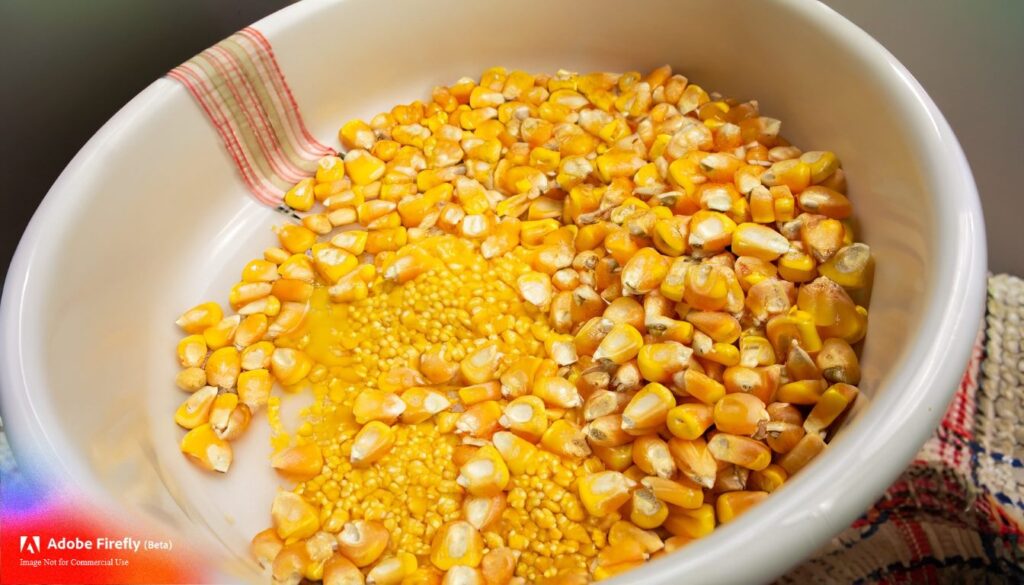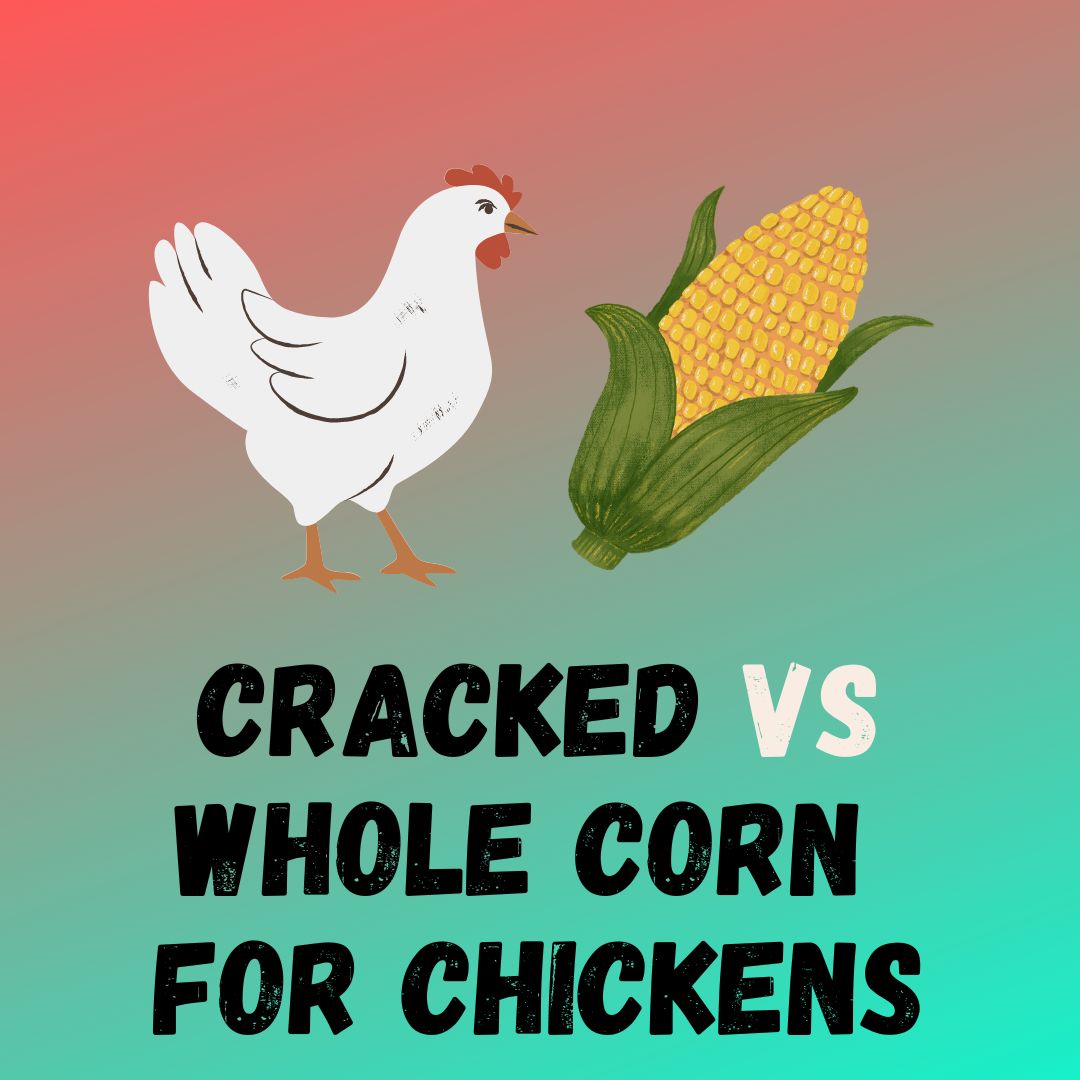When it comes to feeding your backyard chickens, one of the decisions you’ll face is whether to offer them cracked corn or whole corn. Both options have their advantages and considerations, and choosing the right one depends on various factors, including your chickens’ nutritional needs and your specific goals for their diet. In this comprehensive guide, we’ll explore the differences between cracked corn and whole corn, their benefits, potential drawbacks, and how to incorporate them into your chickens’ diet effectively.
So, Why Corn is a Popular Chicken Feed? Corn, in various forms, is a staple in many chicken diets around the world. It’s prized for its availability, affordability, and versatility as a feed ingredient. Whether you’re a backyard chicken keeper or a commercial poultry farmer, you’ve likely encountered the choice between feeding cracked corn and whole corn to your flock.
Understanding Cracked Corn and Whole Corn
Before we delve into the benefits and considerations of each, let’s clarify what cracked corn and whole corn are:
- Cracked Corn: Cracked corn is corn that has been mechanically cracked or broken into smaller pieces. It’s often used as a supplemental feed for chickens and other poultry. The cracking process enhances digestibility and makes it easier for chickens to consume.
- Whole Corn: Whole corn, on the other hand, is exactly what it sounds like—a whole kernel of corn, usually dried and stored in its natural form. It’s a common ingredient in many complete chicken feeds and can also be offered as a standalone feed.
Now that we’ve introduced the basics, let’s explore the nutritional aspects of cracked corn and whole corn to help you make an informed choice for your feathered friends.
Nutritional Comparison
Protein Content
One of the most significant nutritional differences between cracked corn and whole corn is their protein content:
- Cracked Corn: Cracked corn typically has a slightly higher protein content than whole corn due to the mechanical processing it undergoes. However, the protein content is still relatively low compared to other poultry feed ingredients.
- Whole Corn: Whole corn contains a lower percentage of protein compared to cracked corn. It’s primarily a source of carbohydrates and energy.
Energy Levels
Both cracked corn and whole corn are energy-dense feeds, making them valuable for maintaining chickens’ body heat, especially during colder months. However, there are some differences:
- Cracked Corn: The cracking process makes the energy in cracked corn more readily available to chickens. This can be advantageous during colder weather when birds need quick energy to stay warm.
- Whole Corn: Whole corn contains the same energy content as cracked corn but in a less accessible form. Chickens must break down the whole kernels in their gizzard, which can take longer and may produce more sustained energy.
Nutrient Composition
Beyond protein and energy, let’s explore the overall nutrient composition:
- Cracked Corn: Due to the cracking process, cracked corn may offer slightly improved nutrient digestibility compared to whole corn. This can be particularly beneficial for young or less efficient eaters.
- Whole Corn: While whole corn provides similar nutrients, it contains the entire kernel, including the bran and germ. This means it retains more of the corn’s natural oils, which can contribute to the overall diet’s fat content.
Impact on Egg Production
Many chicken keepers are concerned about how their chosen feed affects egg production. Both cracked corn and whole corn can influence egg production, but in different ways:
- Cracked Corn: The improved digestibility of cracked corn may lead to better utilization of nutrients, potentially supporting consistent egg production. However, it’s essential to balance it with other feeds to ensure proper nutrition.
- Whole Corn: Whole corn’s slower digestion rate might not provide an immediate boost in egg production. However, it can be a valuable component of a balanced diet that promotes overall hen health.
Understanding these nutritional differences sets the stage for making an informed decision about what to feed your chickens. In the next sections, we’ll explore the advantages of cracked corn and whole corn to help you decide which one aligns with your goals and the needs of your flock.

Advantages of Cracked Corn
Improved Digestibility
One of the primary advantages of cracked corn is its enhanced digestibility. The mechanical cracking process breaks the corn kernels into smaller pieces, making it easier for chickens to break down and absorb the nutrients. This can be especially beneficial for young or less efficient eaters in your flock.
Decreased Risk of Impaction
Whole corn kernels, while energy-dense, can pose a risk of impaction in some chickens, particularly those that have trouble breaking down and digesting the whole kernels. Cracked corn’s smaller pieces reduce the risk of impaction, promoting better digestive health in your birds.
Easier for Chicks and Young Birds
Chicks and young chickens might struggle to consume whole corn kernels effectively. Cracked corn’s smaller size makes it more manageable for these younger birds, helping them access the energy and nutrients they need for growth.
Enhanced Mixing with Other Feeds
Cracked corn can be more easily mixed with other poultry feeds, creating customized blends that meet specific nutritional requirements. This flexibility allows you to tailor your chickens’ diet to their needs, adding variety and potentially reducing overall feed costs.
While cracked corn offers several advantages, it’s crucial to remember that it should be part of a balanced diet rather than the sole source of nutrition for your chickens. In the next section, we’ll explore the advantages of whole corn to help you make an informed choice.
Advantages of Whole Corn
Nutrient Retention
Whole corn retains more of its natural oils and nutrients compared to cracked corn. These nutrients, including fats and vitamins, can contribute to your chickens’ overall health and well-being.
Satisfying and Engaging for Chickens
Chickens enjoy pecking and scratching for their food, and whole corn kernels provide an engaging and satisfying experience for them. The process of breaking down and consuming whole corn can keep your chickens active and mentally stimulated.
Slower Consumption
Whole corn takes longer to consume compared to cracked corn. Chickens must work to break down the kernels in their gizzard, promoting slower eating habits. This can be particularly advantageous in preventing overeating, especially in free-range or pastured flocks.
Better for Cold Weather
During colder months, chickens require more energy to maintain body heat. Whole corn, with its slower digestion rate, can provide sustained energy throughout the day, helping your flock stay warm and comfortable in chilly weather.
Incorporating whole corn into your chickens’ diet can offer these advantages, but it’s essential to do so in moderation and as part of a well-balanced feeding plan. We’ll cover considerations for feeding corn in the next section.
Considerations for Feeding Corn
When deciding whether to feed cracked corn or whole corn to your chickens, keep the following considerations in mind:
Balance with Other Feeds: Corn, whether cracked or whole, should not be the sole source of nutrition for your chickens. A balanced diet for chickens typically includes a mixture of grains, protein-rich feeds, vitamins, and minerals to ensure their overall health.
Avoiding Excessive Consumption: Chickens tend to favor corn’s taste, which can lead to overconsumption if not carefully monitored. Excessive corn intake can unbalance their diet and potentially result in nutrient deficiencies.
Potential Impact on Egg Yolk Color: Corn-based diets can influence the color of egg yolks, giving them a deeper yellow or orange hue. If you desire a specific yolk color for your eggs, this can be an advantage or a consideration depending on your preferences.
Suitable Corn Storage: Whether you choose cracked corn or whole corn, proper storage is essential to maintain freshness and prevent mold or contamination. Store corn in a cool, dry place, and consider using airtight containers to protect it from pests.
In the next section, we’ll provide guidance on how to feed corn to your chickens effectively, whether you opt for cracked corn or whole corn.
How to Feed Corn to Chickens
Mixing with Other Grains: If you decide to feed corn to your chickens, it’s best to incorporate it into a balanced diet that includes other grains, protein sources, and essential nutrients. Mixing corn with other feeds ensures that your chickens receive a well-rounded nutrition profile.
Use as a Treat or Supplement: Corn can be offered as a treat or supplement rather than a primary feed source. This approach allows you to control the amount of corn your chickens consume and helps prevent dietary imbalances.
Recommended Daily Amounts: The amount of corn you offer depends on your chickens’ age, size, and dietary requirements. As a general guideline, corn should make up no more than 10% of their daily diet. For young chicks, reduce the amount further, focusing on higher-protein feeds for optimal growth.
Feeding Chicks and Adult Birds: Chicks have different dietary needs than adult chickens. While corn can be part of their diet, prioritize feeds designed for young birds that provide essential nutrients for growth. As your chickens mature, you can adjust their diet to include more corn if desired.
By following these guidelines, you can effectively incorporate corn into your chickens’ diet while maintaining their overall health and nutrition. However, it’s essential to address some common misconceptions about feeding corn to chickens in the next section.
Common Misconceptions
Can Corn Replace Complete Chicken Feeds?
Corn, whether cracked or whole, should never replace complete chicken feeds. Complete feeds are specifically formulated to provide chickens with the essential nutrients they need for optimal health, egg production, and growth. Corn lacks the comprehensive nutritional profile necessary to meet all these requirements.
Does Corn Make Chickens Fat?
While corn is energy-dense and can contribute to weight gain if consumed excessively, it won’t inherently make chickens fat when fed in moderation as part of a balanced diet. The key is to monitor corn consumption and ensure it doesn’t comprise more than 10% of their daily diet.
Is Corn Suitable for All Seasons?
Corn can be a valuable part of your chickens’ diet year-round. However, its benefits may be more pronounced during colder seasons when chickens require additional energy to maintain body heat. Adjust the amount of corn accordingly based on your chickens’ specific needs and the weather conditions.
Conclusion
In the debate between cracked corn and whole corn for chickens, there’s no one-size-fits-all answer. Both options offer advantages, and the choice depends on your chickens’ needs, your feeding goals, and how you plan to incorporate corn into their diet.
Remember that corn, whether cracked or whole, should complement a well-balanced diet that includes other grains, protein sources, vitamins, and minerals. Using corn as part of a varied diet can provide your chickens with energy, entertainment, and a delightful treat without compromising their overall health.
Ultimately, the key to successful chicken nutrition lies in thoughtful planning and a commitment to meeting your flock’s specific dietary requirements. Whether you choose cracked corn, whole corn, or a combination of both, your chickens are sure to appreciate the tasty addition to their daily meals.

94% of pet owners say their animal pal makes them smile more than once a day. In 2007, I realized that I was made for saving Animals. My father is a Vet, and I think every pet deserves one. I started this blog, “InPetCare”, in 2019 with my father to enlighten a wider audience.

